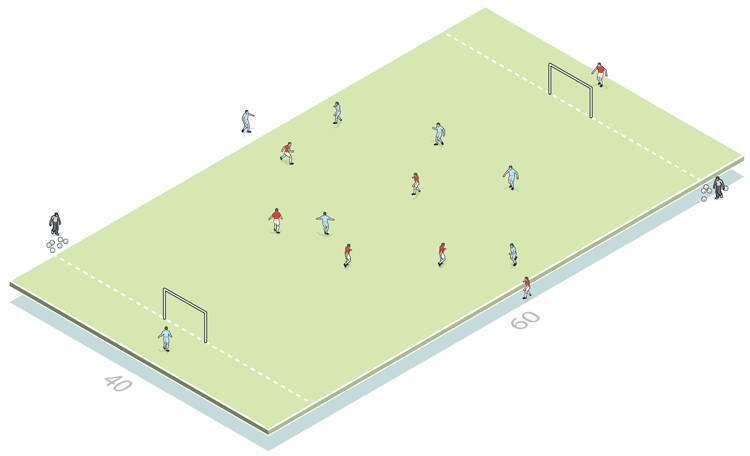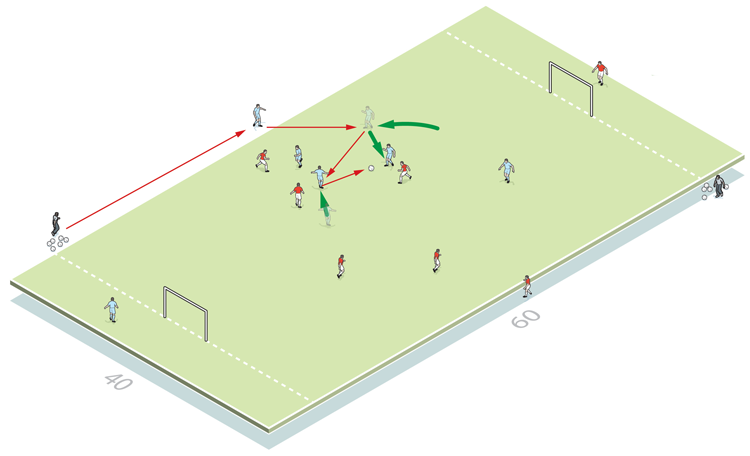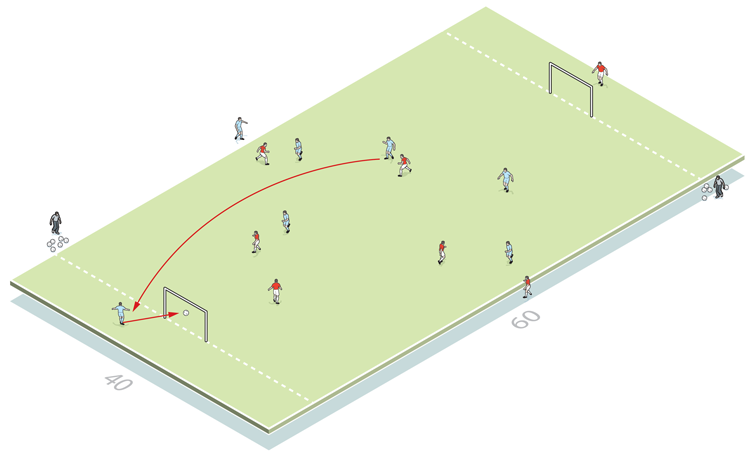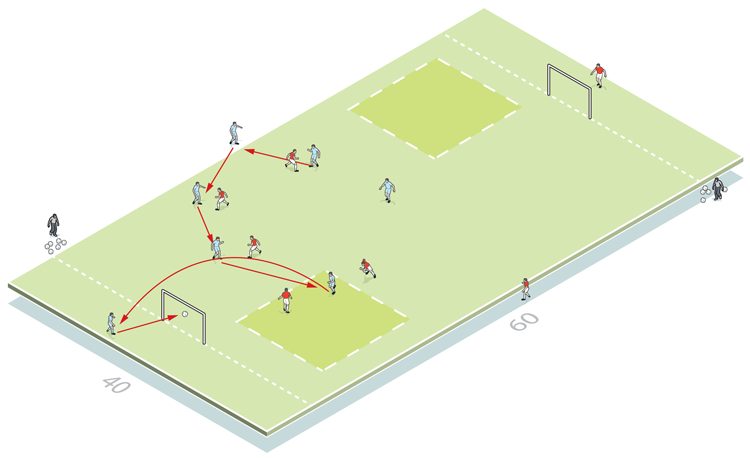You are viewing 1 of your 1 free articles
Deadly transitions
This session examines how we condition a player technically, tactically, physiologically and psychologically when attacking and defending transitions in a small-sided competition-based game. It’s important to practise this because it improves our mastering of a scenario that appears regularly in matches...
| Area | Up to 60x40 yards |
| Equipment | Cones, goals, bibs |
| No. of Players | 5v5 plus two targets and two wide players |
| Session Time | Main session 30mins, Progressions 20mins |
This session examines how we condition a player technically, tactically, physiologically and psychologically when attacking and defending transitions in a small-sided competition-based game.
It’s important to practise this because it improves our mastering of a scenario that appears regularly in matches – namely the attacking team regaining possession and aiming to create space, passing the ball quickly, then playing to a target player in a zone to score.
The session is also good for defenders – their task is simply to organise well, stay alert and aim to regain possession as quickly as possible.
What do I get the players to do?
Setting up as shown (1a), the ball starts with one of the two wide players – we will alternate which of these starts. Only one player from each team is allowed in the end zones – these are the target players and must remain in that space. No other players can enter.
It’s 5v5 in the middle with the aim of the team in possession working space so as to flight the ball into the target player (1b), who must finish one-touch (1c).
1a

1b

1c

Should the ball go out of play, a new ball comes back in from the wide player as quickly as possible.
In addition, the two wide players and the target men can offer support to the 5v5 and can be passed to if needed, but unless a pass is played in the air a target man cannot make a scoring attempt on goal.
Each game should last three minutes with 45 seconds rest before the next one begins. We repeat this eight times, ensuring the two target players and two wide men are rotated for each game.
What are the key things to look out for?
Maintaining a high tempo is very important so as to ensure pressure is placed on transitions for both defenders and attackers.
In terms of technical proficiency, speed and accuracy of pass are important, particularly the pass made in the air to the target man.
Tactically, each team of five must rotate positions so as to create space for players, whilst maintaining awareness of defensive balance. For the defending team, we’re looking at their ability to press quickly and be compact.
Physically, repeated sprints, continued movement and high-intensity activity are important. And we’re looking for players to understand the psychological aspects of the practice as well, to include good communication with team mates to co-ordinate attacks and ‘the press’, whilst also being alert to deal with fast transitions, even with little recovery time.
How do I progress the session?
To progress, we can reduce the number of touches allowed, change the number of passes required (minimum of three), or condition the pass to the target man to come from a first-time pass.
We can also create specific areas on the pitch where the attacking team must move the ball to before the final pass (2).
2

Related Files
Editor's Picks
Deep runs in the final third
Using the goalkeeper in build-up play
Pressing principles
Intensive boxes drill with goals
Penetrating the final third
Creating and finishing
My philosophy
Pressing initiation
Compact team movement
Coaches' Testimonials

Alan Pardew

Arsène Wenger

Brendan Rodgers

Carlos Carvalhal

José Mourinho

Jürgen Klopp

Pep Guardiola

Roy Hodgson

Sir Alex Ferguson

Steven Gerrard
Coaches' Testimonials

Gerald Kearney, Downtown Las Vegas Soccer Club

Paul Butler, Florida, USA

Rick Shields, Springboro, USA

Tony Green, Pierrefonds Titans, Quebec, Canada
Join the world's leading coaches and managers and discover for yourself one of the best kept secrets in coaching. No other training tool on the planet is written or read by the calibre of names you’ll find in Elite Soccer.
In a recent survey 92% of subscribers said Elite Soccer makes them more confident, 89% said it makes them a more effective coach and 91% said it makes them more inspired.
Get Monthly Inspiration
All the latest techniques and approaches
Since 2010 Elite Soccer has given subscribers exclusive insight into the training ground practices of the world’s best coaches. Published in partnership with the League Managers Association we have unparalleled access to the leading lights in the English leagues, as well as a host of international managers.
Elite Soccer exclusively features sessions written by the coaches themselves. There are no observed sessions and no sessions “in the style of”, just first-hand advice delivered direct to you from the coach.









